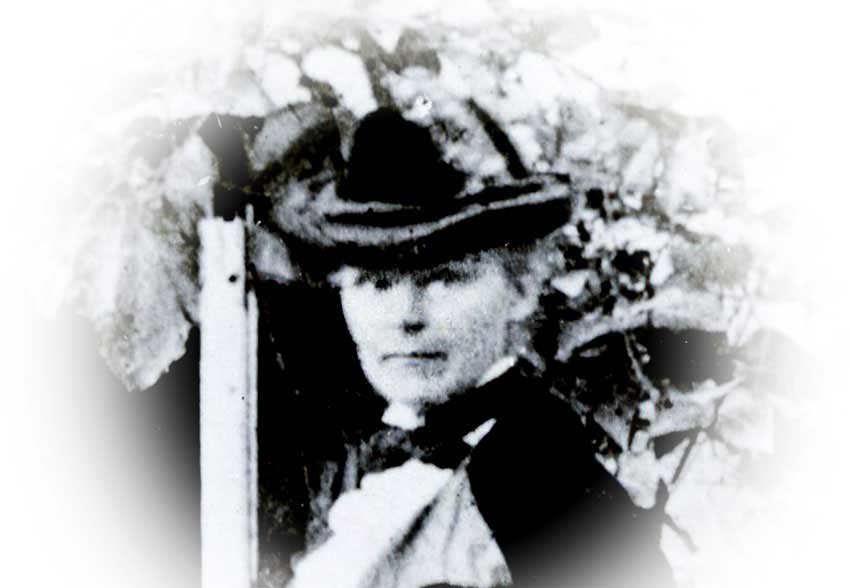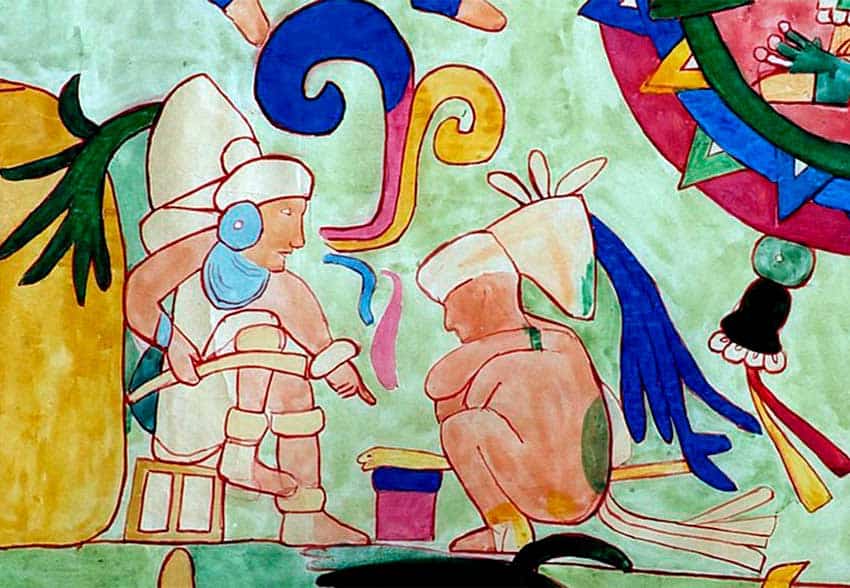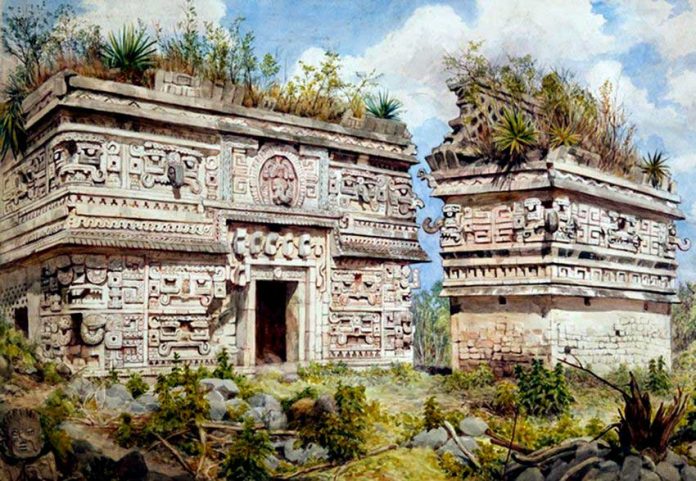In 1894, a man living near the famed ruins of Teotihuacán, 50 kilometers from modern Mexico City, discovered a small, pre-Hispanic house whose walls were covered with beautifully colored murals.
The place was called Teopancaxco or “La Casa de Barrios.” The paintings were the first of their kind found at Teotihuacán and visitors considered them spectacular.
Weather and time eventually did their damage to the murals and today we would have little idea of how they once looked if it were not for an extraordinary Englishwoman named Adela Breton who had fallen in love with Mexico’s ruins and who painstakingly reproduced these murals as watercolors.
Mary Frech, author of Adela Breton, a Victorian Artist Amid Mexico’s Ruins, says, quoting James Langley:
“Adela made the most comprehensive record of the murals at Teopancaxco. Her re-creation of the colours of the murals is unsurpassed compared with the few colour reproductions available, and thus constitutes an irreplaceable memorial of the now destroyed masterpieces.’”

What was an unmarried Victorian gentlewoman doing in Mexico before the turn of the century, 5,500 miles from home?
Exploring, painting, sketching, measuring and photographing not only Mexico’s best-known archaeological sites like those at Chichén Itzá but, it seems, even obscure ruins from the extensive Teuchitlán Tradition of western Mexico which, it was generally believed, were unheard of before archaeologist Phil Weigand gazed upon the Guachimontones in 1969.
Proof of Adela Breton’s keen observations in Jalisco came to light when the Museum of Bristol decided to digitize many of her works and publish them on the internet. For the first time, people outside Bristol could see Breton’s sketches of the now famous Circular Pyramids of Teuchitlán in Jalisco.
“Accurate drawings of the Guachimontones made in 1896?” exclaimed Jalisco archaeologist Rodrigo Esparza. “That’s amazing!” Even more amazing was the discovery, again thanks to the Bristol Museum, that Adela Breton had taken the first known photographs of the three largest “Guaxi mounds,” as she labeled them.
Did Breton publish anything related to the Guachimontones? The answer is yes, but apparently only a few words. Here is what she says in a paper delivered at the International Congress of Americanists in 1902:
“Teuchitlán is a small town at the foot of a long spur of [Tequila] volcano . . . . At Teuchitlán, obsidian rejects are thickly strewn over a great extent of ground. In addition to the obsidian, it has a most interesting ancient site on the summit of the hill, and the remarkable mounds and circles called Huaerchi Monton half-way up.”

Breton was able to reach this remote corner of Jalisco thanks to a train line built only a few years before, a modernization project of President Porfirio Diáz. She brought with her plenty of trunks, her horse and her ever resourceful guide, Pablo Solorio, who somehow learned that a mound housing an untouched tomb had been discovered near the town of Etzatlán and had recently been opened.
After visiting the Guachimontones, Adela went to the Mound of Guadalupe and gives us what is probably the first description of the unearthing of a burial site in western Mexico. “Unfortunately,” she reported, “there was no skilled supervision, no data were secured and most of the figures were broken.”
Fortunately, however, the resourceful Adela was on hand for the event and recorded, according to Mary Frech, that “the mound was about 40 feet high and held a burial with pots, jewelry, clay ‘portrait’ figures ranging from 12 to 20 inches tall and other artifacts.” Of course, she sketched a number of those broken figures and even photographed the Mound of Guadalupe, of which today little is left to see.
Adela Catherine Breton was born in London in 1849. After the death of both her parents she was “easily convinced” by pioneer in archaeological techniques Alfred Maudslay to travel to Chichén Itzá to make sketches which would allow Maudslay to check the accuracy of his own drawings, before publishing his Biologia Centrali-Americana. Thus began her curious career as an archaeological artist.
Upon arriving in Yucatán, Adela developed a turbulent relationship with Edward Thompson, the United States consul there. According to the Harvard University Archives, Thompson wrote to Fredric Putnam, curator of the Peabody Museum of Archaeology, accusing Breton of “meddling” at Chichén Itzá.
Says Thompson: “To my horror I found out the day I left Chichén that she proposes to return to Chicheen shortly for another period of time. She certainly is an artist as regards landscapes at least and she has made one painting in the intervals of her work for Maudslay that is really very nice. She brought out the artistic points of the ‘Nunnery’ in a wonderful manner.”
[soliloquy id="72949"]
After a few months, he writes again to Putnam: “She has a very peculiar character but I think that she is one of those persons that improves as one knows them better. She most certainly is a true artist.”
In the opinion of Matt Williams of the Bath Royal Literary & Scientific Institution, Adela “developed into a world-renowned archaeological copyist thanks to her drawings of friezes, carved reliefs, painted plasters and other cultural treasures – some of which are now the only records that remain of items long since lost to vandalism and decay.”
According to Williams, Adela was a well-seasoned traveler and she once wrote: “I used to live chiefly on air and a few peanuts for the long riding journeys — 30 miles without any breakfast.”
“Adela chose not to marry,” he adds, “as it was the only thing that guaranteed a woman’s independence in those days. She wanted to be free to travel and chart her own destiny.”
According to Kate Devlin, a writer for Trowelblazers.com, Harvard anthropologist Alfred Tozzer once said, “You look at Miss Breton and set her down as a weak, frail and delicate person who goes into convulsions at the sight of the slightest unconventionality in the way of living. But I assure you, her appearance is utterly at variance with her real self.”
Adela Breton died at age 73 in Barbados in 1923, and left most of her work and collection to the Bristol Museum & Art Gallery.
• Photo credits: Bristol Culture/Bristol Museums, Galleries & Archives.
The writer has lived near Guadalajara, Jalisco, for more than 30 years and is the author of A Guide to West Mexico’s Guachimontones and Surrounding Area and co-author of Outdoors in Western Mexico. More of his writing can be found on his website.
